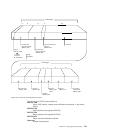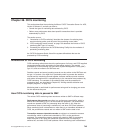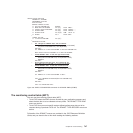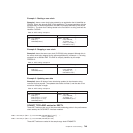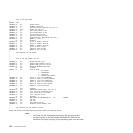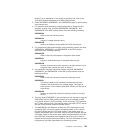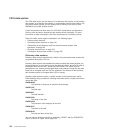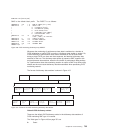DFHMCT TYPE=EMP
There must be a DFHMCT TYPE=EMP macro definition for every user-coded EMP.
The PERFORM operand of the DFHMCT TYPE=EMP macro tells CICS which user
count fields, user clocks, and character values to expect at the identified user EMP,
and what operations to perform on them.
The DFHMCT TYPE=EMP macro has an ID operand, whose value must be made
up of the ENTRYNAME and POINT values specified on the EXEC CICS MONITOR
command.
Note that, in a single run of CICS, the format of all performance records is identical,
and that the length of records increases relative to the number of data fields in the
user EMPs defined in the MCT.
The maximum amount of user data that can be added to performance records is
16384 bytes. The user data is divided into user areas. Each user area is defined by
coding an entry name qualifier on the ID operand of the DFHMCT TYPE=EMP
macro. If you code the same entry name when defining multiple EMPs, all the
EMPs operate on fields in the same user area. Correspondingly, by coding different
entry names you can append multiple user areas to the monitoring records.
Provided that the overall maximum of 16384 bytes is not exceeded, each user area
can contain:
v 0 through 256 counters
v 0 through 256 clocks
v A single 8192-byte character string.
Each user area is uniquely referenced by its entry name. For example:
DFHMCT TYPE=EMP,ID=ENTRYA.1,PERFORM=...
DFHMCT TYPE=EMP,ID=ENTRYA.2,PERFORM=...
DFHMCT TYPE=EMP,ID=ENTRYB.1,PERFORM=...
DFHMCT TYPE=EMP,ID=ENTRYB.2,PERFORM=...
DFHMCT TYPE=EMP,ID=1,PERFORM=...
In the above examples, in addition to the system-defined performance fields, three
user areas, ‘ENTRYA’, ‘ENTRYB’, and ‘USER’, are defined (if no entry name is
specified, the default is ‘USER’). If the application codes an EMP invocation with
ENTRYNAME(ENTRYA), only the ENTRYA user area is operated on. The only
operation that spans all user areas is DELIVER, which operates across the whole
monitoring area.
DFHMCT TYPE=RECORD
The DFHMCT TYPE=RECORD macro allows you to exclude specific
system-defined performance data from a CICS run.
Each field of the performance data that is gathered at the system-defined EMPs
belongs to a group of fields that has a group identifier. Each performance data field
also has its own numeric identifier that is unique within the group identifier. For
example, the transaction sequence number field in a performance record belongs to
the group DFHTASK, and has the numeric identifier ‘031’. Using these identifiers,
you can exclude specific fields or groups of fields, and reduce the size of the
performance records.
Examples of MCT coding with MONITOR commands
These examples show some EXEC CICS MONITOR commands with the MCT
entries that must be coded for them, to start a user clock, stop a user clock and
update user data.
748 Customization Guide




